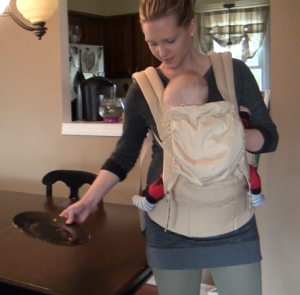
Everywhere I go I see babies looking at the world from the five-point-harness of a car seat. These car seats are truly incredible! They snap right out of their base and transform into a carrier in a stroller, a carrier in a shopping cart, even a high chair by flipping a restaurant high chair upside down and snapping that car seat right in!
A recent research study replicated a study done in the 1940’s in which researchers tested children ages three, five, and seven for motor skills and coordination. Startling results: today’s five-year-olds tested at the same level as three-year-olds from 60 years ago. They found a two year delay compared to 60 years ago across the board! Researchers dug a little deeper. 60 years ago the norm for walking was eight to ten months, now it is 12-15 months. This has left a lot of scientists scratching their heads.
What else happened in the past 60 years, besides the “removable car seat craze?” In 1992 researchers discovered that Sudden Infant Death Syndrome (SIDS) could be prevented by placing babies on their back to sleep, and in 1997 the “Back to Sleep Campaign” was launched. In subsequent years babies began falling an average of six months behind on their milestones and early developmental skills, but experts say back-sleeping has reduced the incidence of SIDS by more than 50 percent. Are we trading milestones for safety? Can’t we have both?
Of course we need car seats, in the car! Let’s leave them there.
The other issue researchers think contributes to the lost skills over the past 60 years is all the bouncy seats, swings, and vibrating chairs out there. Babies are spending more time than ever in “containers” and they are losing important skills because of it. There is even a term for it. Babies requiring therapy because of the flattening of the back of their heads are called “container babies” or “bucket babies.”
Of course we need to keep putting our babies to sleep on their backs, but what about play time? During awake, alert play time babies should be spending at least five minutes several times per day on their tummies from day one, and by six months, babies should be on their tummies for at least two hours a day. Tummy time is when babies develop neck and trunk strength, begin to roll and crawl, and improve their vision skills and motor skills. It is so vital to early development, and yet a lot of babies never get tummy time anymore.
Tips to avoid container baby syndrome:
- Use slings instead of car seats to carry babies around in public.

- Use vertical slings for older babies and horizontal slings for newborns, but lower the fabric so your baby can see out of it.
- As soon as babies have some trunk support, place the baby right in the shopping cart. That way your baby can practice trunk stability and head control while shopping.
- Make tummy time a priority during play time.
- Replace the bouncy seat in the corner of the kitchen with a pack and play.
Let’s liberate the babies! Building awareness is half the battle and when we know better, we do better. Help spread the word, leave the car seats in the car as much as possible, and allow tummy time several times throughout the day.
References:
Kluger, J. (2014). How Cuddling Saves Tiny Babies. Time Magazine.
Move Forward PT (2018). https://www.moveforwardpt.com/SymptomsConditionsDetail.aspx?cid=53d90264-1846-4b86-891f-0facc63db3e8

